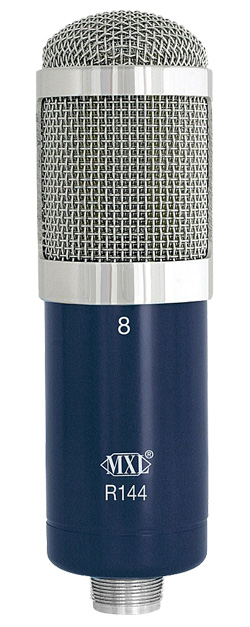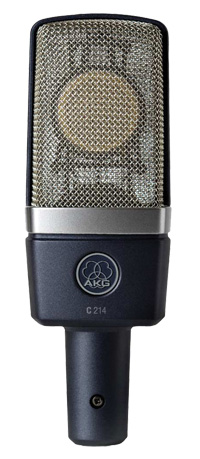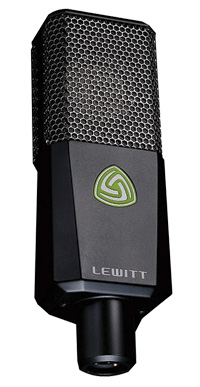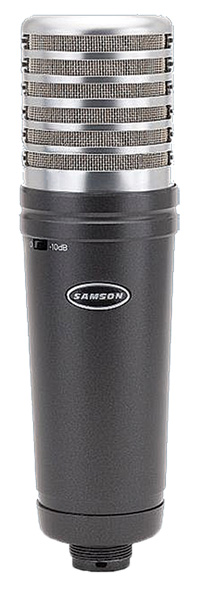Gear Review: Four New Look Studio Microphones
Gear Review: Four New Look Studio Microphones
I recently saw a meme that gave a good definition of a musician: A person who puts $5000 worth of gear into a $500 car to drive to a $50 gig. It may not be the most effective business model but it shows how much we value quality, and that has its price, right?
Well yes, it makes sense to pay premium money for a Gibson guitar or a Ludwig drum kit, but luckily some of the all-important tools of creation keep getting more affordable, and there are now pieces of gear available that can do amazing things for a fraction of your money. Problem is, there are so many and they all claim to be better than the next one. And so the debate rages whether to stick with the tried and trusted, or venture into the alluringly cheap but unknown. Today we will confuse this debate just a little more by reviewing four studio microphones for the budget-conscious.
We gave these four new look studio microphones to SAE Institute’s Bachelor of Recording Arts degree students for testing, and they put them through the paces on guitar, percussion and male and female vocals to evaluate their strengths and weaknesses. In addition, I used a few of them on a recording project I am currently working on. And here is what we collectively found…

MXL R144 rrp $399
MXL is made by renowned US company Marshall Electronics, who should not be confused with the British guitar amp manufacturer. Their best-known products are Mogami cables, which incidentally are also used in this microphone. The R144 is a ribbon microphone, meaning that there is a lightweight 1.8 micron ribbon in place of the usual diaphragm. The ribbons design has the advantage of an overall smoother response compared to say, dynamic microphones, but it makes the mic rather fragile, so you need to generally handle it with extra care.
So why would you even want a ribbon mic? Well, they are not known for a neutral transparent sound, and thats exactly their allure. Their characteristic warm sound can help in numerous situations, such as taming the strident overtones found in electric guitar amps and close-range brass. In the midrange they seem to provide the glue that ties together instrument groups like backing vocalists, brass and string sections. If you have been recording everything with an inexpensive large diaphragm condenser mic, a ribbons opposing characteristics can provide a great contrast. And often, a touch of EQ will help you make the most of their unique sound.
However, finding the right spot to put your ribbon mic and the right application can take a bit of practice. Due to their figure of eight polar pattern they have a pronounced proximity effect, a boominess that may occur when they are placed close to the source. You also risk damage to the fragile ribbon by placing them close to overly loud sound sources, such as kick, snare or even close-up vocals without pop shield. A decent pre-amp with plenty of clean gain is needed to combat their low output – and phantom power must be off when connecting one of these mics.
Put to the test, the R144s sound compared very well with SAE’s Cascade Fatheads, another brand of entry level ribbon mics. While the low end seemed to be smoother on the Fathead I did like the more even top end of the R144, which also seems to respond to EQ better. On softer, female jazz vocals in particular, there was a noticeable edge to the R144, while the Fatheads mostly remained in control of male vocals. The R144 was also our preferred option on acoustic guitar. So long as you place it with care, it will deliver a round and warm sound, especially on finger-picked guitar lines. The R144 can withstand up to 130dB SPL, making it a good choice for my AC30, where it provided excellent tone, especially when paired with a SM57. Testing the transient response on spoken word, rap and percussion revealed the predictable finding that ribbons may not be the preferred choice for this, but everything this microphone claims to be good at it certainly delivers.
Where the stalwarts of ribbon microphone technology such as the Royer 121 or the Coles 4038 will easily cost you upwards of two grand, the R144 comes in at a mere $399 rrp, together with stunning looks, a sturdy shock mount and a hard plastic carry case for protection. At that price it must be one of the most affordable ways of getting more colour into your recordings.

AKG C214 rrp $769
AKG really doesn’t need a long introduction. For more than half a century the Austrian company has been one of the market leaders in microphone design and continue to innovate how we capture sound. They have a range of classic microphones to their name, and I use several of their products on a daily basis.
Their C214 large diaphragm condenser is pitched as half a C414 XLII, one of AKG’s most renowned microphones. As a more cost-effective alternative, it retains the sturdy build and excellent sound quality, while trading off some of the less-oft used features of its bigger sibling. The one-inch single diaphragm is set at fixed cardioid, and the PADs and bass roll-off circuitries have been simplified. Also for the geeks amongst us, this is a back-electret condenser rather than a true one.
The microphone has a solid all-metal die-cast body and comes in a classy carry case together with a shock mount and pop sock.
An easily overlooked aspect of the C214 is its suspended capsule, reducing mechanical noise on stage or in less-than-ideal studio situations, once a hallmark of more expensive condenser microphones. This means you only record what you intend to record, increasing the clarity of your mixes. Pair this with the maximum level of 156dB SPL (with PAD engaged) and it’s excellent sensitivity, and you have a rather versatile tool.
Aimed at the home recording market, the $769 rrp price tag puts it at the higher end of the affordable condenser category, so we were curious how its sound would justify the price. Upon listening, we were relieved that the mic does indeed live up to the AKG standards, with its full and slightly dark character, but detailed clarity and presence. This is a professional, rich and weighty sound that many inexpensive condensers can only dream of achieving. It sounded great on anything we threw at it during our tests, including vocals, acoustic guitar, cymbals and percussion.
As for the claim that it sounds like the 414 at less than half the price? We can’t quite confirm this. Overall the more expensive mic taught us that you always get what you pay for, even if the differences can feel marginal and subjective at times.
Paying for a 414 will not only give you more features, but also a more focused and natural sound in both the low and the high end. This was more evident in the vocal recordings than the instruments, and there might even be the odd occasion where you would prefer the C214 on vocals, but it puts to rest any notion that you can cheat your way to an expensive recording.
 Lewitt LTC240 rrp $379
Lewitt LTC240 rrp $379
Lewitt is a young Austrian company that was founded by former AKG employee, Roman Perschon, just five years ago. Consequently, their microphones owe a great deal to AKG’s product line, and the LCT240 on offer here vaguely fits into the C414 theme we have been considering before, featuring a similar shape and noiseless electronic switching in AKG style.
This fixed cardioid diaphragm is smaller than on AKG’s 414 and 214 models, and so is the price at just $379 rrp. As such, comparing the sounds of these products would not be entirely fair.
What impresses about this mic is the electronic circuitry on offer. There are three roll-off and three PAD settings, with a back-illuminated display indicating which one is selected. This is not only extremely flexible (and somewhat reminiscent of the C414), but also great for dimly-lit recording or live situations. If you want it to, the onboard memory will even store information about clipping and automatically adjust the PAD setting after detecting excessive peak levels. You can also lock your settings, which I quickly made use of after accidentally pushing the switches a couple of times.
To keep the mic under $400 the manufacturers have chosen to skimp on the accessories instead. While it does include a pop sock, this mic has just a basic custom clip rather than the customary shock mount, and comes with a soft pouch rather than a travel case. I already have too many cases anyway and didnt really feel I would be missing out, although a proper shock mount is always welcome in my studio.
When we first recorded with this new mic, we learned to our surprise that facing it with the bright green logo towards the sound source recorded the empty room instead. The standard side-addressing practice does not seem to apply to the Lewitt. Instead you need to face the side with the switches towards your source. Strange, but not entirely unreasonable in most typical home recording situations.
And what about the sound? The Lewitt LTC240 claims to be optimised for live and studio sound, podcasting, and home recording of vocals and instruments. Thats pretty much everything. When we put it through the paces on guitar, percussion and vocals we noticed a bright sound with a natural sounding top end, and a lack of body.
There is clarity galore, thanks to a pronounced presence peak at around 9kHz, but you may have to revert to EQ to give the recorded sounds some fullness. In podcasting and video blogging this might not be so important, and so Im confident thats the market Lewitt were aiming at. In the home recording studio this mic would still be useful for the bright, modern type of vocal production that cuts through layered backing tracks, but most likely I wouldnt often be tempted to move the roll-off switch from its flat position.
The Lewitt does not sound tinny or brittle, the way some modern budget condensers do. It manages to have a sparkly, pleasing top end, but the 2/3″ diaphragm will probably only go so far in capturing the weight of a vocal or instrument. All in all, this mic seems a good advertisement for the fledgling company, and leaves me keen to study some of their large diaphragm products, like the LCT640, which would be a much closer rival to the revered C414.
 Samson MTR201 rrp $259
Samson MTR201 rrp $259
US-based Samson started as a two-man operation more than three decades ago, and has since become a company catering for many applications in pro audio at a very competitive price point. At last years NAMM trade show in LA they released a new range of LDC (large diaphragm condenser) microphones into the lowest price bracket of the market. Their MTR series is comprised of general-purpose mics aimed at the home studio.
There was a period when almost daily we’d see the release of a new inexpensive large diaphragm condenser that would claim to match the established giants in one form or another. While we found out that mostly there is no free lunch, we may have overlooked that this inexpensive market now has undergone its own evolution, and what once was looked down upon as a range of cheap knock-offs, now has become a product catalogue with its own history of research and development, perfecting the art of value-for-money.
The uni-directional, fixed-cardioid MTR201 was released in 2013 and is arguably the result of this development. It will cost you a scant $259 rrp and packages a shock mount, a carry case and pop filter with this presentable and sturdy, die-cast microphone. It also features a switchable 10dB PAD, making for an impressive 142dB SPL maximum level. This should suffice for most recording situations and is even stage-worthy.
The rugged shock mount is reminiscent of the famous Neumann spiders and is in stark contrast to the rather flimsy, although surprisingly effective clip-on pop filter. Interestingly, like the AKG, this microphone has a good solid feel, and also manages to suspend the capsule from external vibrations, even at this price point. Nothing is sacred.
The proof then may be in the sonic pudding. Putting it to the test, we recorded the obligatory guitars, vocals and percussion and compared the results to some of the other mics on test, as well as a venerable Neumann TLM103. Considering that all the mics we used were considerably more expensive than the Samson, it stood its ground rather well. The recorded sounds were endowed with a suitable fullness. The low end and lower mid range were smooth and consistent.
Things became a tiny bit abrasive in the upper mids with 2 and 4kHz standing out, giving the sound a brash forwardness. The top end again was pleasing, although with less presence and less air than some stalwart microphones.
Interestingly, these problems were easily rectified with a wide, gentle EQ dip through the 1 to 4kHz region, and a narrower boost in the vocal-wise all important 6 to 7kHz area. This didn’t turn the microphone into a Neumann, but made clear that, with a slight tweak, it is capable of delivering very usable and pleasing results.
One question I could not fully satisfy in the time given, is how the recorded sounds would fare in a busy mix, but it is obvious to me that inexpensive microphones like this one have come a long way in becoming a viable alternative for the budget-conscious, and with some care, are capable of providing great recordings.

